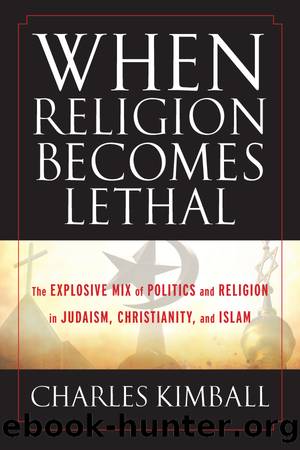When Religion Becomes Lethal by Charles Kimball

Author:Charles Kimball
Language: eng
Format: epub
Publisher: Wiley
Published: 2011-02-16T00:00:00+00:00
Renewal and Reform Movements in Islam
The omission of the role of colonial powers and later superpowers in the relations between Islamic peoples and the West is serious indeed. As we saw in the previous chapter, the once-dominant central Islamic lands experienced uneven decline and fragmentation after the Mongol invasion in the 13th century and, later, the emergence of Western Europe. During the 19th and early 20th centuries, the global reach of European colonial powersâthe British, French, Dutch, and Portugueseâsystematically seized control of most Muslim-majority lands. Eventually, even the Mughul Empire in India, the Safavid Dynasty in Iran, and the Ottoman Empire in the Middle East gave way to Europeâs imperial rulers. The impact and legacies of colonialism are essential in comprehending attitudes and behaviors of Muslims in many lands today, including influential Islamic revival and reform movements that emerged before and especially during times of colonial rule in the 18th and 19th centuries. Reform movements emerged as Muslims feared that European political and economic domination was threatening the cultural and religious values of their Islamic societies. Islam had once led the world, but something had gone wrong. Why, they asked, could Islam not once again be the basis for a comprehensive system? As we will see below, reformers feared similar and distinct influences from colonial rulers. Identifying selected major figures and reform movements illustrates the diverse responses to perceived threats against traditional Islam and clarifies key elements that are central in contemporary debate about the future of Islam.
Renewal and reform are deeply important to Muslims. Muhammad, in fact, was a prophet who (like all prophets) called the community of faith back to Godâs path. A well-known hadith affirms that âGod will send to this umma [the Muslim community] at the head of each century those who will renew its faith for it.â4 Islamic history includes prolific scholars, such as al-Ghazali and Ibn Taymiyya, who claimed this mantle and shaped the thinking and behavior in major segments of the Islamic world.
One of the most important reform movements took root in the Arabian peninsula through the combined efforts of Muhammad ibn Abd al-Wahhab (1702â1791) and Muhammad ibn Saâud (d. 1765). Abd al-Wahhab advocated a rigid version of Islamic law. His call to return to the basics of the Qurâan and early Islam fueled a vigorous attack on what he deemed heretical teachings and practices of Shiâites (e.g., the cult of imams, pilgrimage to various âsacredâ places), Sufi mystics (veneration of saints), and less stringent applications of Islamic law among many Sunnis. While Muhammad ibn Abd al-Wahhab lent the religious guidance, Ibn Saâud was the political leader in what became the Saudi royal family. This combination shaped the religious and political landscape that continues to this day in the Kingdom of Saudi Arabia. Numerically, the Saudis represent a tiny fraction of the larger Sunni Muslim community. But the influence of their narrow sectarian approach within the most conservative of four recognized schools of Islamic law has been massive.5 Resources from oil revenues have
Download
This site does not store any files on its server. We only index and link to content provided by other sites. Please contact the content providers to delete copyright contents if any and email us, we'll remove relevant links or contents immediately.
Signature in the Cell: DNA and the Evidence for Intelligent Design by Stephen C. Meyer(3103)
The Secret Power of Speaking God's Word by Joyce Meyer(3072)
Real Sex by Lauren F. Winner(2988)
The Holy Spirit by Billy Graham(2917)
The Gnostic Gospels by Pagels Elaine(2497)
Jesus by Paul Johnson(2331)
Devil, The by Almond Philip C(2305)
23:27 by H. L. Roberts(2223)
The Nativity by Geza Vermes(2204)
Chosen by God by R. C. Sproul(2143)
All Things New by John Eldredge(2136)
Angels of God: The Bible, the Church and the Heavenly Hosts by Mike Aquilina(1944)
The Return of the Gods by Erich von Daniken(1913)
Angels by Billy Graham(1906)
Knowing God by J.I. Packer(1834)
Jesus of Nazareth by Joseph Ratzinger(1785)
The Gnostic Gospel of St. Thomas by Tau Malachi(1769)
Evidence of the Afterlife by Jeffrey Long(1761)
How To Be Born Again by Billy Graham(1759)
